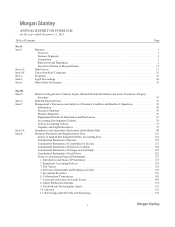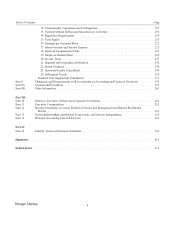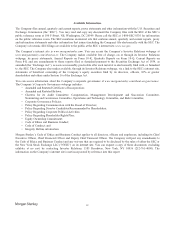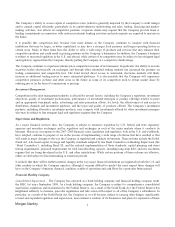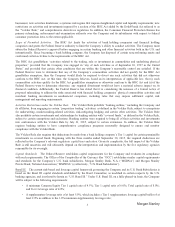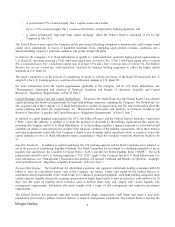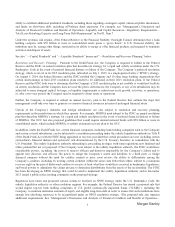Morgan Stanley 2015 Annual Report Download - page 9
Download and view the complete annual report
Please find page 9 of the 2015 Morgan Stanley annual report below. You can navigate through the pages in the report by either clicking on the pages listed below, or by using the keyword search tool below to find specific information within the annual report.
businesses; new activities limitations; a systemic risk regime that imposes heightened capital and liquidity requirements; new
restrictions on activities and investments imposed by a section of the BHC Act added by the Dodd-Frank Act referred to as
the “Volcker Rule;” and comprehensive derivatives regulation. In addition, the Consumer Financial Protection Bureau has
primary rulemaking, enforcement and examination authority over the Company and its subsidiaries with respect to federal
consumer protection laws, to the extent applicable.
Scope of Permitted Activities. The BHC Act limits the activities of bank holding companies and financial holding
companies and grants the Federal Reserve authority to limit the Company’s ability to conduct activities. The Company must
obtain the Federal Reserve’s approval before engaging in certain banking and other financial activities both in the U.S. and
internationally. Since becoming a bank holding company, the Company has disposed of certain nonconforming assets and
conformed certain activities to the requirements of the BHC Act.
The BHC Act grandfathers “activities related to the trading, sale or investment in commodities and underlying physical
properties,” provided that the Company was engaged in “any of such activities as of September 30, 1997 in the United
States” and provided that certain other conditions that are within the Company’s reasonable control are satisfied. If the
Federal Reserve were to determine that any of the Company’s commodities activities did not qualify for the BHC Act
grandfather exemption, then the Company would likely be required to divest any such activities that did not otherwise
conform to the BHC Act. At this time, the Company believes, based on its interpretation of applicable law, that (i) such
commodities activities qualify for the BHC Act grandfather exemption or otherwise conform to the BHC Act and (ii) if the
Federal Reserve were to determine otherwise, any required divestment would not have a material adverse impact on its
financial condition. Additionally, the Federal Reserve has stated that it is considering the issuance of a formal notice of
proposed rulemaking to address the risks associated with financial holding companies’ physical commodities activities and
merchant banking investments in nonfinancial companies, including rules that may impose additional capital, risk
management and reporting requirements.
Activities Restrictions under the Volcker Rule. The Volcker Rule prohibits “banking entities,” including the Company and
its affiliates, from engaging in certain “proprietary trading” activities, as defined in the Volcker Rule, subject to exemptions
for underwriting, market-making-related activities, risk-mitigating hedging and certain other activities. The Volcker Rule
also prohibits certain investments and relationships by banking entities with “covered funds,” as defined in the Volcker Rule,
subject to certain exemptions and exclusions. Banking entities were required to bring all of their activities and investments
into conformance with the Volcker Rule by July 21, 2015, subject to certain extensions. In addition, the Volcker Rule
requires banking entities to have comprehensive compliance programs reasonably designed to ensure and monitor
compliance with the Volcker Rule.
The Volcker Rule also requires that deductions be made from a bank holding company’s Tier 1 capital for certain permissible
investments in covered funds. Beginning with the three months ended September 30, 2015, the required deductions are
reflected in the Company’s relevant regulatory capital tiers and ratios. Given its complexity, the full impact of the Volcker
Rule is still uncertain and will ultimately depend on the interpretation and implementation by the five regulatory agencies
responsible for its oversight.
Capital Standards. The Federal Reserve establishes capital requirements for the Company and evaluates its compliance
with such requirements. The Office of the Comptroller of the Currency (the “OCC”) establishes similar capital requirements
and standards for the Company’s U.S. bank subsidiaries, Morgan Stanley Bank, N.A. (“MSBNA”) and Morgan Stanley
Private Bank, National Association (“MSPBNA”) (collectively, “U.S. Bank Subsidiaries”).
Basel III. The current risk-based and leverage capital framework governing the Company and its U.S. Bank Subsidiaries is
based on the Basel III capital standards established by the Basel Committee, as modified in certain respects by the U.S.
banking agencies, and is referred to herein as “U.S. Basel III.” Under U.S. Basel III, on a fully phased-in basis, the Company
will be subject to the following requirements:
• A minimum Common Equity Tier 1 capital ratio of 4.5%; Tier 1 capital ratio of 6.0%; Total capital ratio of 8.0%;
and Tier 1 leverage ratio of 4.0%;
• A supplementary leverage ratio of at least 5.0%, which includes a Tier 1 supplementary leverage capital buffer of at
least 2.0% in addition to the 3.0% minimum supplementary leverage ratio;
3



